The importance of lichens
This is the audio (below)for this halt. The text below is a transcription of the audio! The audios do not contain all the content written in the text to keep the audios engaging. If you want to have more details, check out the text. Enjoy!
We are looking at the tree next to the bench in front of the student accommodation at Warrender Park Crescent. Look at the pictures below to help you spot the exact location of the tree.
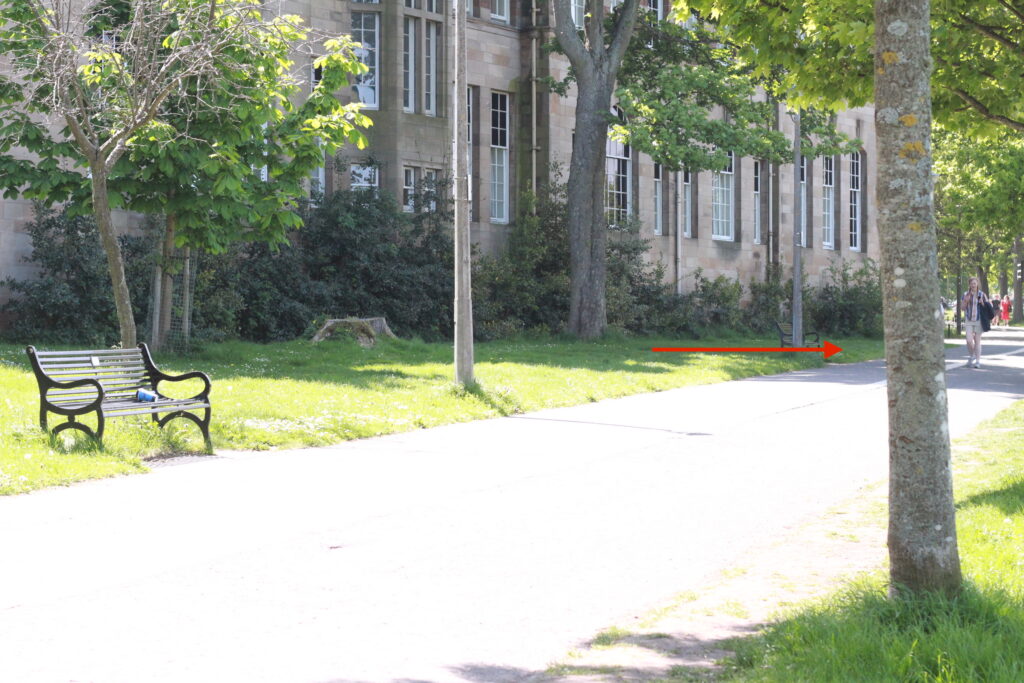
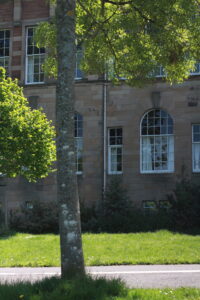
Lichens, inhabitants of extreme environments. They change the way we see space and the earth.
June 18, 2016, a module from a spacecraft lands in the steppes of Kazakhstan. The astronauts get out, but not alone. Below their seats are a hundred organisms in a box. Among the samples sent into space for a year and a half, there are several species tolerant to extreme conditions including bacterial spores, algae and tardigrades (Box 3) and some species of lichens. This experiment was part of the international astrobiology consortium named “Biology and Mars Experiment” (BIOMEX). The astronauts incubated the organisms outside the International Space Station under extra-terrestrial conditions. A few of these organisms can survive if they are protected from solar radiation, but few – apart from a few species of lichen – can live in space conditions, exposed to cosmic ray radiation. Indeed, when the lichens returned from space, they showed no sign of physiological changes nor in their photosynthetic activity, which they resumed 24 hours after being rehydrated.
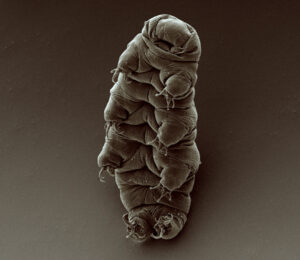

But how can these small organisms live in such inhospitable environments?
Lichens living in these extreme regions have a number of adaptations that allow them to survive. They can continue to use photosynthesis as an energy source while enduring temperatures near -20°C. Lichens can absorb water from a saturated, snow-covered habitat. The trick of lichens is the dormant, inactive state they enter when conditions are not good. They stop photosynthesis and can start again when conditions are favourable again.
The impressive tolerance of lichens to sunlight and other stars, to drought, to heat and to extreme changes between freezing, thawing and heating is due to their protection and repair mechanisms at the cellular level. These adaptation methods are not yet well known. Moreover, the symbiotic association of the lichen allows it to be more resistant.
Another experiment on a species known to be very tolerant – Circinaria gyrosa – showed that even exposure to a UV radiation dose 12,000 times lethal to humans (6 kilograys of gamma radiation) has no effect on the species. When the dose is doubled (12 kilograys of gamma radiation – 2.5 times the lethal dose for tardigrades), the ability of the lichens to reproduce is impaired, but the species can continue to photosynthesise and survive. This experiment shown that this species is tolerant to Mars atmosphere, temperature, pressure and UV radiation.

Lichens can live in extreme environments but that does not explain why they matter to us?
Lichens are pioneer species – they are a link between the animate and the inanimate.
Every environment is constantly changing, this is due in part to climatic conditions, but also to the communities of organisms that make up the environment. Each living being is active in its habitat, it changes it and is changed by it. In environments devoid of vegetation, such as ancient volcanoes or mountain peaks or even cities, pioneer species such as lichens, mosses or grasses create space for other species to colonise.
But how?
Lichens’ penchant for rocks has literally changed our planet. Lichen erosion of rocks occurs in two ways. First, lichens, along with the roots of mosses and grasses, create crevices in rocks as they grow and develop. Second, lichens use their arsenal of chemicals to digest the rock. The lichen’s ability to erode rock puts it in the category of physical forces. But more than that, lichens as they die and decompose create nitrogen-rich humus and shape the first soils for other plants to grow. Lichens transform the inanimate, like rocks, by including them in the metabolic cycle of life. These symbiotic organisms are the links between what is animate and what is not, what lives and what does not live.
Lichens allow environments to form and prepare a habitat for other plants to colonize. This can be observed in any environment in a dynamic succession phase (see diagram below).
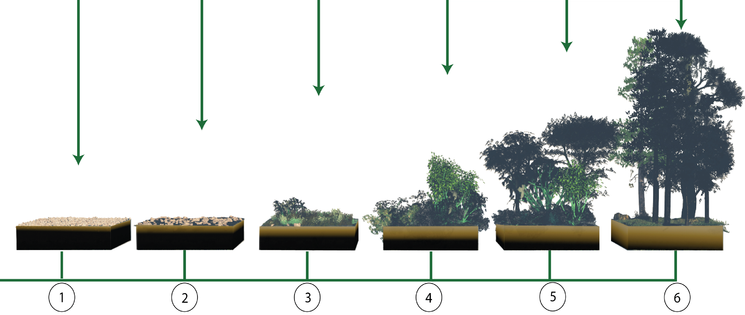
Lichens at the base of the food web
In the extreme environments they inhabit, lichens are the primary producers of the food chain and are sources of food for many herbivores like reindeer. Their absence or disappearance could cause the extinction of many individuals.
In our regions, lichens are inhabited by many species such as ladybugs and springtails. If you observe carefully you may see some insects (spiders, aphids amongst others). Even birds use the thallus of lichens to form their nests. Gastropods also feed on the lichen thallus (see photo below).
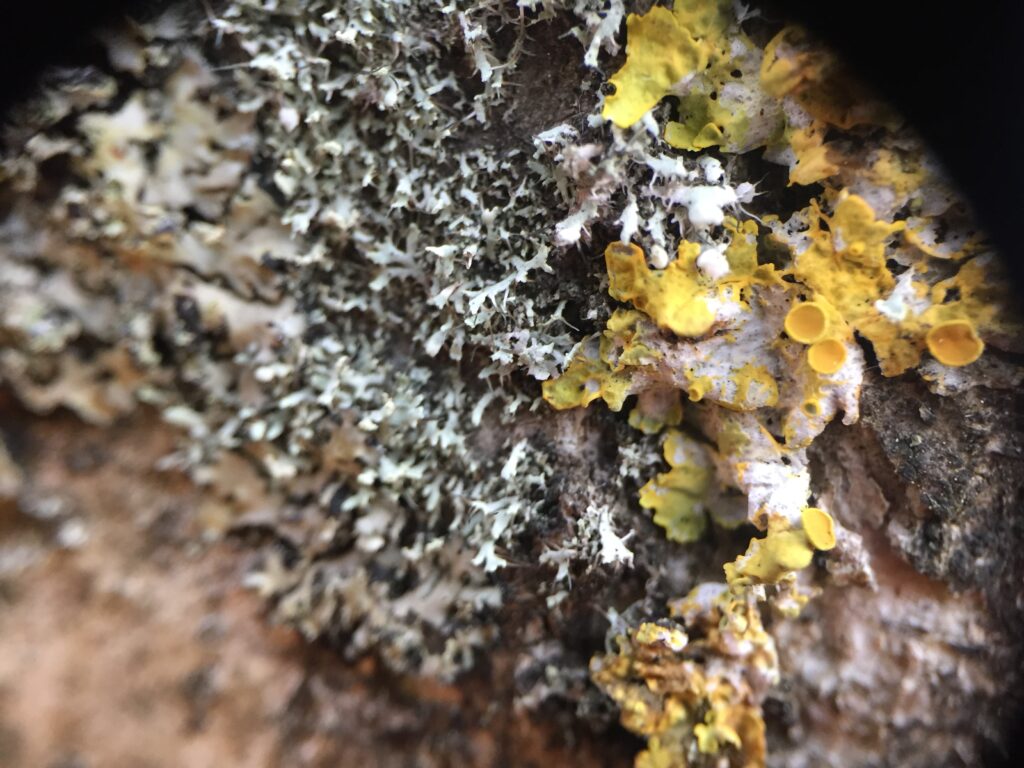

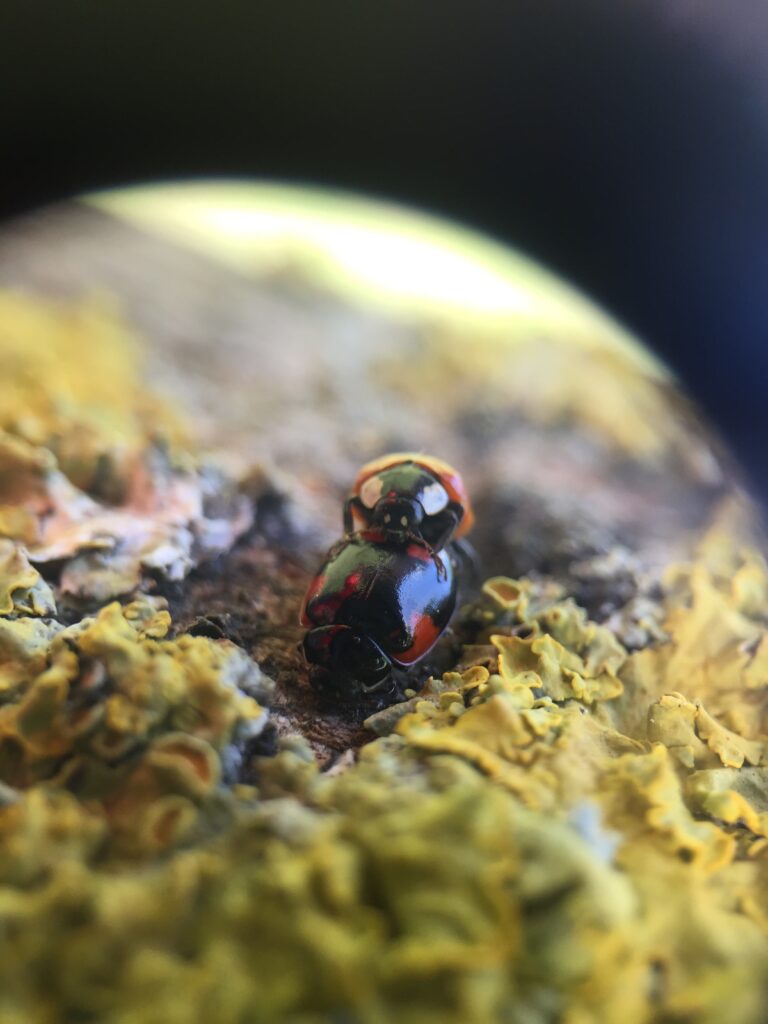
Lichens store carbon
Lichens cover 8% of the earth’s surface (Ahmadjian, 1995). Through the process of photosynthesis, lichens store carbon and release oxygen changing the composition of the atmosphere. Lichens do not represent a carbon capture as great as trees, which are larger and more massive, but they do store a significant proportion of carbon in cities. New research indicates that lichens (along with mosses) take up about 3.9 petagrams Pg (corresponding to 3900,000,000,000 kg) of carbon per year, which is similar in magnitude to the annual carbon releases from biomass-forest burning (3.6 Pg/yr) and fossil fuel burning (7 Pg/yr) (Elbert et al., 2012).
Lichens have an intrinsic value; they matter just because they exist.
In total, there are about 20,000 identified species of lichens. And there are still many species to be discovered. For example, in the tropics on the island of Sri Lanka, more than 3,000 different species of a single genus, Graphidacea, have been recorded (information from a conference of the British Lichen Society). In Texas, 7000 species have been identified while 200 are recorded at the Mexican border. This is certainly due to the number of lichenologists – people who study lichens – in the country, which leaves an incredible space for new discoveries (information from a British Lichen Society conference).
We can find lichens of all shapes and colours and on – almost – all substrates. Some lichens live on the east side of the substrate, others on the west side, some are competitive, others live on the ruins of dead lichens. Their diversity is impressive and at the same time frustrating. The probability that the identified species has a twin, but with a different chemistry is very high …. There is thus always something to learn from !
Lichens have an intrinsic value. We regularly try to put a value on living things and on the organisms surrounding us. These methods giving a value (monetary or other) to living beings is important for acknowledging them and for managing natural resources. Nevertheless, these methods consider organisms as passive beings. Lichens deserve their place in the ecosystem as much as humans do.
Activity
Think about the environment in which these lichens are found. What are the important factors ? Access to sunlight, humidity, air quality.
What type of habitat are you in ? Is there any infrastructure that could shade the substrate on which the lichens are found ? Are there roads ? What is the source of pollution emissions ? Is this source close or far away ?
We will talk about the effects of air pollution on lichens later on in this walk, here.
What type of tree are you looking at ?
The tree species can have an effect on lichen communities. For example, ash trees tend to be basic (in their chemistry) while other trees such as birches or oaks are more acidic. With increased atmospheric pollution in cities, the bark is becoming more basic and richer in nitrogen, so we only see species that tolerate these conditions.
Introduction to the lichen of the genus Physcia, species adscendens
We now know the lichen Xanthoria. Can you spot the species Xanthoria parietina on this tree?
I would like to introduce you to lichens of the genus Physcia. It is a blue-green lichen that is very common in the city.
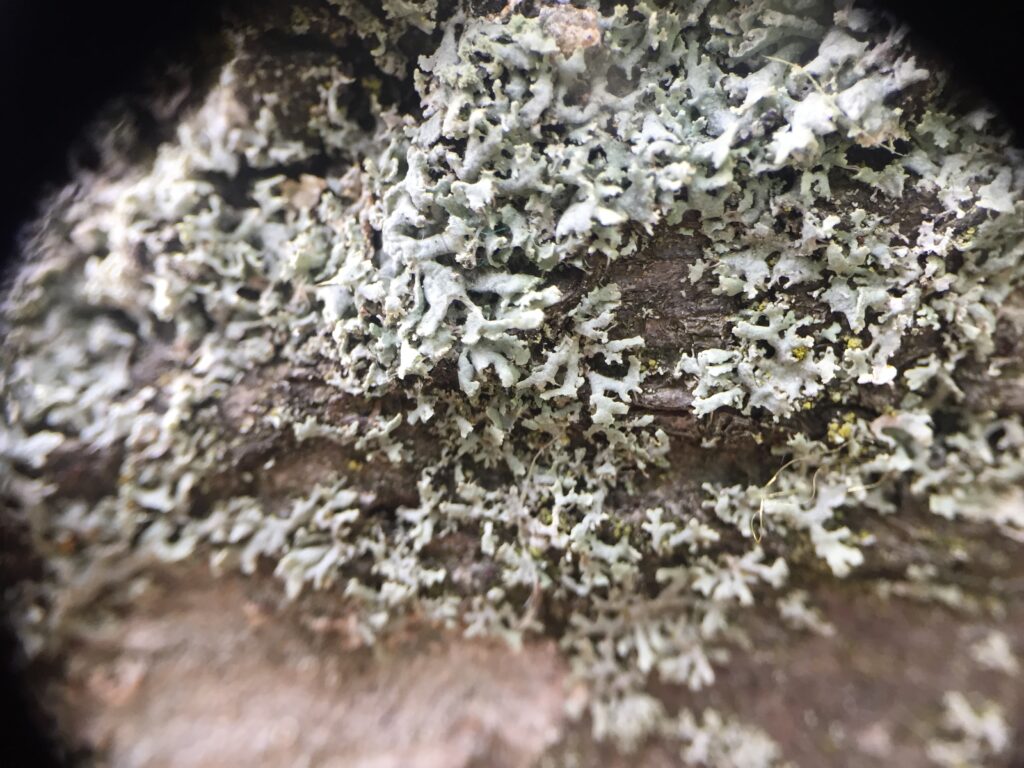
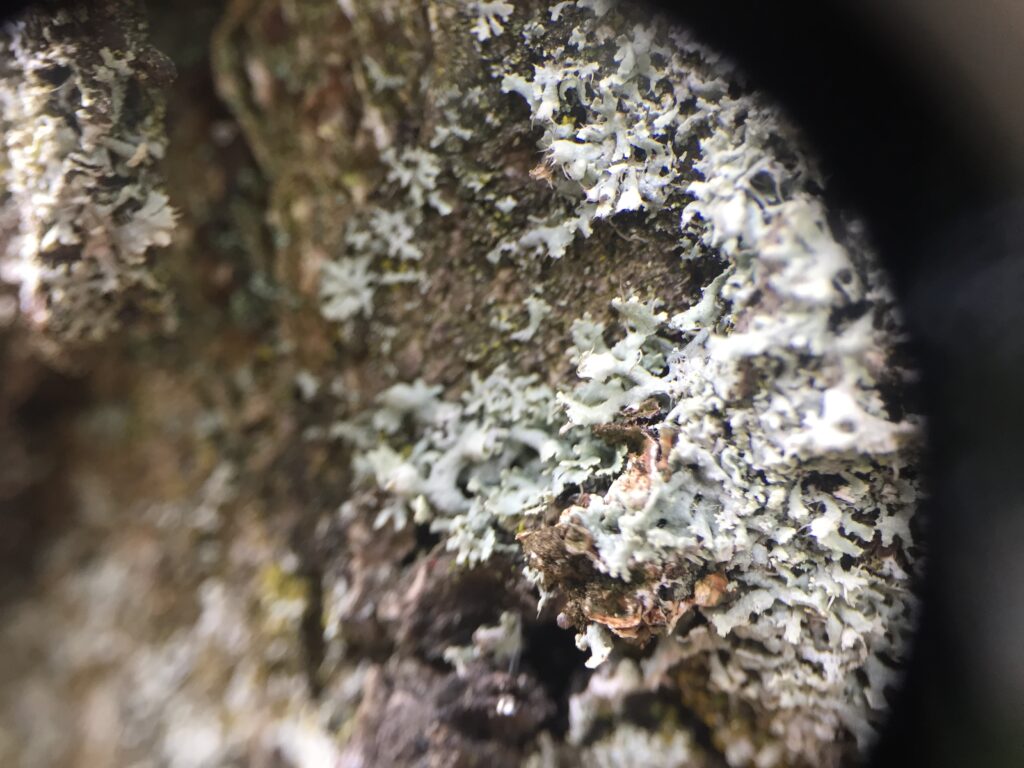
The characteristics of Physcia adscendens are quite simple:
- The tip of the thallus (called a lobe) is shaped like a small hat or helmet.
- If you get even closer with the magnifying glass, you can see the macules. These are the white coloured parts on the thallus. This colour change is created by a heterogeneous distribution of algae. The white parts are the medulla (the fungal part) because in some places the algal layer is absent.
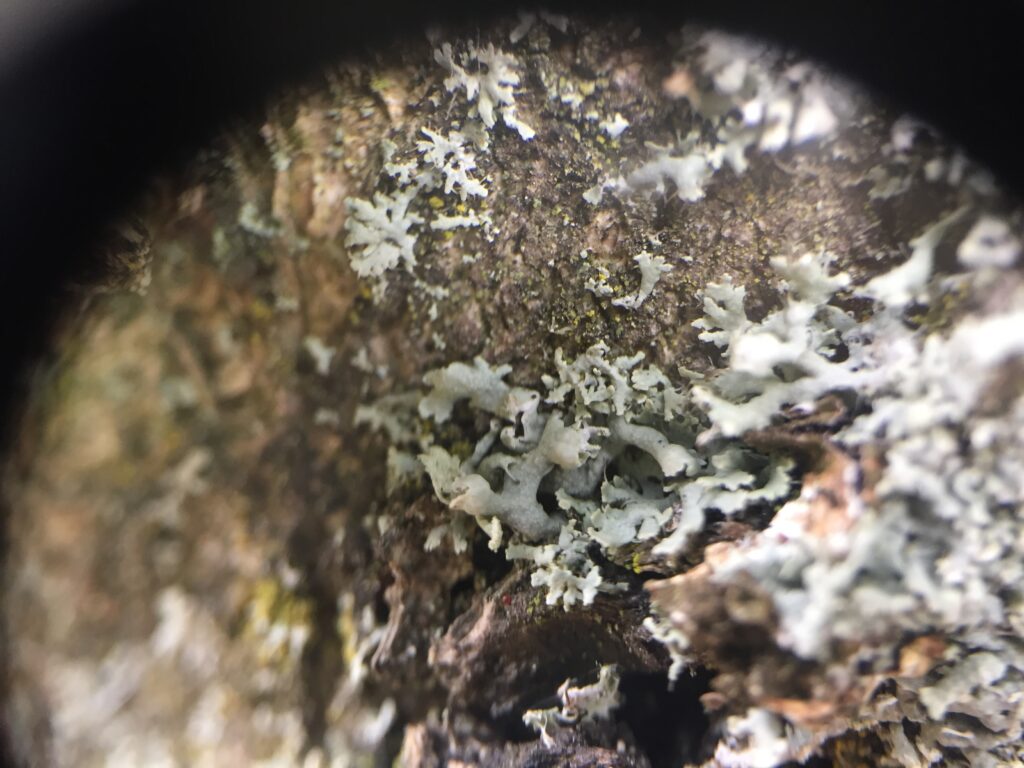
- If you have the opportunity to look at the lichen with a magnifying glass, you will see small hairs coming out of the tip of the thallus, these are called cilia. The surface is ciliated. We do not know exactly the function of these hairs, but they represent one of the characteristics of this genus Physcia.


References
– Ahmadjian, V. (1995). Lichens are more important than you think. BioScience, 45(3), 124.
– Elbert, W., Weber, B., Burrows, S., Steinkamp, J., Büdel, B., Andreae, M. O., & Pöschl, U. (2012). Contribution of cryptogamic covers to the global cycles of carbon and nitrogen. Nature Geoscience, 5(7), 459-462.
– Sánchez, F. J. et al. (2012) ‘The resistance of the lichen Circinaria gyrosa (nom. provis.) towards simulated Mars conditions – A model test for the survival capacity of an eukaryotic extremophile’, in Planetary and Space Science. doi: 10.1016/j.pss.2012.08.005.
Feedback
If you don’t continue the ride, can you give us feedback on your experience here ? It will help us improve!
In our next step we will keep our eyes open to spot the hidden lichens in the city👇🏾👇🏾


